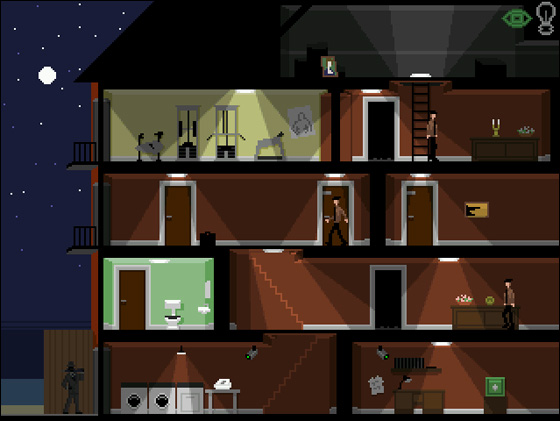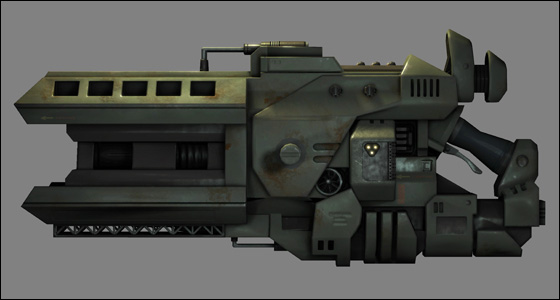Trilby: Art of Theft Critique
January 29th, 2009

This was written several months ago and was going to be featured somewhere else, but I changed my mind as I found it more suitable for this blog.
Ben “Yahtzee” Croshaw is most famous for playing the role of court jester in this industry void of influential game critics with his remarkably popular video segment Zero Punctuation on The Escapist. Trilby: Art of Theft (a freeware adventure title) showcases Croshaw’s natural aptitude to solid game design and clever writing.
You play the role of Trilby, a sophisticated cat burglar versed in the ‘art of theft’. While Trilby is sharper than most, he’s not yet professional, a point which aches at his perfectionist nature. Trilby’s concern over his imperfections provide the means to connect the protagonist (and his character) to the experience at hand.
Preluding each heist is a narrative scene featuring a block of scrolling text in which Trilby prescribes his thoughts of the events layed before him. The text is sort of like a mini-blog that allows the player to get a feel for current Trilby’s woes and worries. This brief insight is interesting not only because it acts as a free ride for Croshaw to display his fine writing skills but also to build understanding between Trilby’s character and the player. This works well in two ways. Firstly, it acts as a driver to encourage the player to be endeavorous with each heist – just as Trilby’s personality exerts – and secondly to justify the game’s difficulty which is steep enough to fall in line with Trilby’s continually high aspirations.
Heists are presented in a two-dimensional doll’s house perspective, allowing the player to see into each room of the building or complex. Throughout each heist is a series of obstacles for the player to crawl through. The obstacles are smaller chunks of gameplay wrapped into the stealth thematic which together constitute the gameplay. Their simple forms and native structure make them flexible set pieces for the environments.

The layout of each area often presents several interweaving, multi-branched passages for the player to traverse. Much like any thief on the late night prowl, you’ll need to understand your environment and plan the best course of entry before leaping into the exercise. While there are some routes obviously more difficult – and usually shorter – than others, quite often there is enough flexibility that you’ll be choosing routes based on personal preferences. The difficulty of each route depends on the obstacles presented. You may find that taking on guards is easier than dodging lasers and so forth. As such you need to have an awareness of where your in-game strengths lie, an attribute which likens itself to the process of assessing and then selecting the most risk averse path. Much like the mindset of a real professional burglar.
The next attribute of theft that Trilby sinks into is observation. Observation is obviously needed in the planning stages, but even more so before the execution. In the same way that a thief sits in the shadows, watching and waiting for the right time to strike you’ll need to do the same. The game complements cat-burglar-like patience and observation with its fundamental mechanics. You can hide in low light, cling to the walls in shadows and in emergencies stick to the ceiling for a limited time in bright light. Each of these options mean that a hiding place is never too far away, allowing you to duck out for a quick second to observe movement patterns of laser, guards, flashing lights before jumping back into play. You’ll need to do this quite frequently as well, which reinforces the importance of stealth.
There are additional techniques which can be bought between heists in exchange for loot as well as existing techniques and attributes. There is quite a diverse make up of options available and all prove useful with no real excess. It is one of the small ways that makes Trilby varied, despite being a largely linear game.
http://au.youtube.com/watch?v=gNGtj9N0FK4
Finally we have execution. Strategy and observation can only get you so far, in reality it’s all up to the execution. That is coming from out of the shadows and making the move to the next progressive area. The game imposes a few restrictions which can be loosened (again, in exchange for loot) such as a limit on alerts and taser uses. The taser (attached to the end of Trilby’s umbrella) stuns enemies for the course of the entire heist and is a safety measure for when they spot you and reach for the alert.
As mentioned Trilby enjoys quite a diverse skill set and even when the scope of techniques begin to tire, the game is sure to throw in new distractions to spice things up. Lock picking is a good example of this, safes and the odd door require the player to jump into a small microgame in which you feed a wire through the key hole.
Trilby’s greatest asset is its ability to place you in the role of the protagonist. The gameplay constituents and the way they click together, all act as building blocks for these exercises of strategy, observation and execution, related to the discipline, and art of theft. Trilby’s characterization then layers on top providing stimulation to the player within the environment. When you fail at a heist, you begin to think just like Trilby as the game’s well executed formation of the core principles of theft (strategy, observation, execution) guilt your failure. It’s all very well thought out and designed, and is one of the more developed independent titles I have played.
You may also be interested in reading this review of the title written by L.B. Jeffries of Pop Matters.
Resistance: Fall of Man Commentaries
January 29th, 2009

When I was away in China my brother bought a second PS3 controller (the overpriced, overdue Dual Shock 3), so since I’ve been home the two of us have been playing the original Resistance in co-operative mode. While I’ve been enjoying Nathan Hale’s tour through Great Britain, the game feels so anemic and grates on you the whole way through. It’s a brilliant, high production show piece for the PS3 and it’s launch (Resistance was a launch title), but it does bore over you a little.
My biggest gripe is that Resistance seemingly doesn’t want to break out of it’s narrow perspective of the first person shooter genre. The core gameplay essentially involves moving from one area to another, gunning down waves of Chimera and then moving to another area and doing it again, albeit in a slightly different fashion. I guess fundamentally there is nothing wrong with this, the shooting is enjoyable, the creative weapons are much the highlight (collect as you go, no limitations imposed) and Chimera make for good cannon fodder. The downside is this eventually becomes an exercise of monotony, there is no real succulence to the running and gunning to spur you on. This repetition in what the game asks of you (shoot, walk some, shoot some more) and the uninspired configuration it provides you with eventually lead into a grind. It’s not completely overbearing, but it does make you feel fatigued very quickly, meaning the game works best in shorter bursts.
At some point in the game you wonder when mission objectives will deviate away from basic shooting but they never really do. The grind doesn’t loosen at all, right up to the anti-climatic ending and it’s a real disappointment to see, as just a couple of small diversions to spice things up would have strengthened the games appeal greatly.
The 1950s Europe meets alien invasion premise is an interesting take which is ultimately never fleshed out enough to become engaging. The narrative is mostly told through transitions of panning well drawn, greyscale artwork depicting the affects that the Chimera scurge has had on the classic landscape.
The voice work is solid but the delivery of narrative is one dimensional and distances you from the unfolding drama regarding the war and Hale himself. Speaking of Hale, he is a bland, boring character who rarely murmurs a word, even when given the chance to. His most interesting asset is perhaps his bald head and the fact that you can tell he was animated by the “Ratchet and Clank guys”. There are two other characters, a female who narrates the supposive heroics of Nathan Hale (which never feel justified as we rarely bare witness to much of it) and another guy which I can’t remember much about. Foot soldiers also throw a few jibes but the 1950s setting makes it difficult for me to decipher whether the (predominately) English and (sometimes) Australian soldiers are authentically recreated. Despite the hiring of dialect writers and so forth, I strongly doubt it.
The environments show promise and quite often liven up a tough firefight. You battle the elements (great snow effects) and move between areas both affected and unaffected by the invasion. This makes for some interesting hybridized landscapes but since most of it is static and not interactive they contribute little to the interaction. The one thing the environments are good for is they always ensure that you feel as though you are trudging through a different place, all the time. It also seems like Insomniac tried to create a historic feel to the game by the use of bloom lighting and soft hues which look nice but frequently wash out the colours too much.
The one thing that Resistance has going for it is the weapon selection; the rift that adds variety, depth and enjoyment to the game. There is a healthy number of interesting alien weaponary at hand and all affect the way you approach a given situation. There’s a sniper rifle which can slow time, hedgehog grenades which explode into spikes, the Hailstorm which fires out green needles and has a crazy secondary fire function which sends out a spiraling ball of rapid fire needles. There’s the bullseye which can lock onto targets, Auger Rifle which shoots through walls and can fire protective shields. Each weapon in this game is very memorable and unique. They’re also fun to use and pretty fun to watch being used as well. As the game progresses you’ll have to switch between these weapons on the fly to react to the changing battle climate. overcome each situation. The weapons go a long way to increase the appeal of this title.

Despite staying true to convention – so far as to say the game feels dated – Resistance is generally a well made first person shooter. I think it deserves much praise for being a launch title that not only looks fantastic but also has a generous length to it in both single and multiplayer. Resistance is so familiar and arguably ‘stale’ that it can only go so far in the small pond it has placed itself in. But even for that small pond it manages to be a success.
Stepping Up
January 26th, 2009
 Just a small buzz to all of you who play games online; I registered for a Playstation Network and Xbox/GFW Live ID last week. I never play games online and I expect that even with these two screen names in hand that’ll probably not change much. Actually I don’t even have an Xbox 360 – I was forced to create a handler for a friend’s Rock Band – so that will make chances even slimmer.
Just a small buzz to all of you who play games online; I registered for a Playstation Network and Xbox/GFW Live ID last week. I never play games online and I expect that even with these two screen names in hand that’ll probably not change much. Actually I don’t even have an Xbox 360 – I was forced to create a handler for a friend’s Rock Band – so that will make chances even slimmer.
Since I don’t have (and don’t intend on buying) an Xbox 360, the Playstation Network ID is the only address worth sharing. I have Call of Duty 4, Resistance: Fall of Man and Metal Gear Online which all have multiplayer online componenets, as well as Home and whatever other features come built in. To be honest I don’t even know if I will even bother playing these games online, I will give it a shot no doubt but perhaps just to see what it’s like. I honestly don’t have the time, nor commitment to any one game to be an active participant in the online community. Hell, I rarely ever leave comments at other people’s blogs.
In ancase, if you’re online and want to add me; DanielPrimed is the screen name for both services. I have a head set too and would love to play/talk games with you.



 Game Design Companion: A Critical Analysis of Wario Land 4 - $7.99
Game Design Companion: A Critical Analysis of Wario Land 4 - $7.99 Level Design: Processes and Experiences
Level Design: Processes and Experiences Speed Boost: The Hidden Secrets Behind Arcade Racing Design - $5.99
Speed Boost: The Hidden Secrets Behind Arcade Racing Design - $5.99 Adventures in Games Analysis: Volume I - $5.99
Adventures in Games Analysis: Volume I - $5.99







